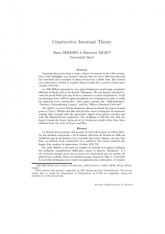
- Consulter un extrait
- Année : 1997
- Tome : 2
- Format : Papier
- Langue de l'ouvrage :
Anglais - Class. Math. : 13A50, 13P99, 14L30, (14D25, 14Q15)
- Pages : 221-244
Invariant theory has been a major subject of research in the 19th century. One of the highlights was Gordan's famous theorem from 1868 showing that the invariants and covariants of binary forms have a finite basis. His method was constructive and led to explicit degree bounds for a system of generators (Jordan 1876/79).
In 1890, Hilbert presented a very general finiteness result using completely different methods such as his famous “Basissatz.” He was heavily attacked because his proof didn't give any tools to construct a system of generators. In his second paper from 1893 he again introduced new techniques in order to make his approach more constructive. This paper contains the “Nullstellensatz,” “Noether's Normalization Lemma,” and the “Hilbert-Mumford Criterion !”
We shortly overview this development, discuss in detail the degree bounds given by Popov, Wehlau and Hiss and describe some exciting new development relating these bounds with the (geometric) degree of projective varieties and with the Eisenbud-Goto conjecture. The challenge is still the fact that the degree bounds for binary forms given by Jordan are much better than those obtained from the work of Popov and Hiss.

